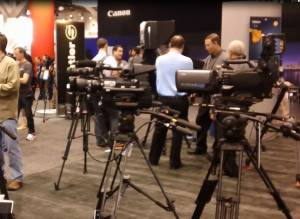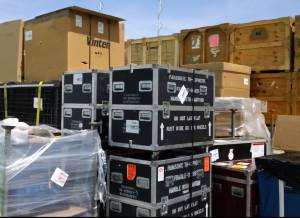Broadcasting’s Miracle Mile
In many ways, the annual NAB exhibits and convention marks the beginning of a new virtual fiscal year for manufacturers involved in the broadcast and concurrent industries. It marks a new product virtual fiscal year, and it’s the unwritten deadline for new hires. A help wanted sign in an NAB exhibit, or a lack of new products, is often not a good sign. Who wants to risk cutting a purchase order for vaporware or promises? Conversely, some companies may be rising so fast they may offer some great career opportunities they couldn’t fill soon enough.

The NAB exhibits are the industry’s Miracle Mile. Exhibitors go all out to put their best foot forward, spending untold sums of money renting exhibit space; designing, building and wiring booths and displays; shipping in equipment; and transporting, feeding and housing sufficient sales, marketing and technical staff to intelligently answer questions. It is also undeniably the optimum time for exhibitors to gather sales leads from those who pre-qualify themselves by taking the time, registering, spending the money, making the trip, visiting an individual exhibitor’s booth, and having his or her badge scanned.
Marketing and selling broadcast equipment has changed almost as much as the gear itself. The rise and fall of industry leaders can often be judged by the size and position of their booth space, the crowds they attract and their stock price. On Monday and Tuesday, crowds swarm long-time industry leader’s big exhibits in prime locations. Exhibits back by the restrooms are typically comparatively empty on those days. As Tuesday turns to Thursday, news and buzz travels fast. Visitors spread out to see exhibits they may not have considered spending time in before they arrived to investigate products and solutions they heard about but didn’t anticipate. Such is the way and the beauty of the NAB Show.
I’ve known a few people who blow into ‘Vegas on Monday, leave Tuesday afternoon and claim to have seen the show. Express visits like that are like buying a pair of binoculars and looking through them backwards because you think it helps you see the big picture. We broadcast engineers know better.
Tire kicking or buying?
There’s no question broadcast hardware and software solutions continue trending better, faster and less expensive, and more so every year. That’s good news for stations, facilities and broadcast engineers, but not always good news for established manufacturers. Some major manufacturers are not selling as many expensive, name-brand products as they hoped. One reason is that their legacy products work so well, there often isn’t a pressing need for wholesale replacement when a software upgrade will do. Now that most of the domestic broadcast industry has made the transition to DTV and HD, the trick is to parlay that investment into profit, instead of keeping up with the competition and FCC requirements. Today’s economic climate, complete with a growing list of unknowns, only exacerbates the situation.
Spectrum repacking will undoubtedly generate significant sales for transmitter and antenna manufacturers, sometimes at the cost of not spending or investing in other a

reas .
Goodbye, SDI. Hello, IP.
As IP bandwidth becomes less of an issue, the need for dedicated formats for professional and broadcast video such as SDI is on the wane. If there is one trend most likely to stand out at this year’s NAB, it would be the introduction of more IP-based video gear.
This trend brings a parallel need for new digital test and measurement gear. The many forms digital video is taking require a new stable of test gear to ensure its validity. Fortunately, much of the new test and measurement gear is more in the form of software and less in the form of the traditional stand-alone units. Software test and measurement keeps prices down and the footprints small.
This is also a banner year to investigate replacing reliable old hardware such as camera support and lighting. There have been many advancements and some genuine quantum leaps in these hardware-intensive areas. Like their electronic counterparts, most new tripods, heads and lights perform measurably better, are easier and safer to transport and handle, and less expensive than their predecessors.
ENG and satellite news gathering equipment is undergoing a similar leap forward. As cellular news gathering systems endure real-world tests, manufacturers have responded with upgrades and updates better suited to meet the challenges of large-market, big-story newsgathering.
Hands off or hands on?
If your station’s broadcast automation system leaves a thing or two to be desired, you are not alone. Individual stations outside of groups seldom reveal to their competitors their master control automation issues, and it seems to be one of the best kept secrets in the industry. It seems few systems can perform all tasks at all stations flawlessly or without excuses.
A handful of the problems can be blamed on Microsoft Windows, but not all. Some automated playout systems can’t handle OS upgrades. Others seem like they can only reveal later that new problems replaced the old problems. The automated playout portion of some systems may work perfectly, but perhaps the system won’t accept FTPs. Rather, some systems require files to be opened and played in real-time baseband for ingest. This may not be news to you and your station, but if your system isn’t quite as perfect as you had hoped, you are not alone.
As you look at automation systems, ask tough questions. What makes television broadcasting so interesting is that while every station shares the same goals, most have different strategies and systems to achieve those goals. This legacy makes it difficult for manufacturers to make one-size-fits-all master control automation solutions. The more information they can gather about individual stations helps manufacturers. The more questions you ask helps you learn if a particular vendor’s solution completely fulfills all your station’s needs. Excuses are so 20thcentury.
Several companies, new and old, have entered and some have quietly exited the turnkey automated master control system business. Of course, perfection is in the eye of the beholder. In most cases, surprise, surprise, you get what you pay for. Mix-and-match systems seem to be the solution most stations somewhat reluctantly end up adapting. If there is any key to success, it would have to be to consider the solution as a single-purpose appliance, not to be upgraded and well-isolated from the Internet, unless the manufacturer recommends otherwise. My advice on maintaining master control automation systems: If it ain’t broke, don’t fix it, and for gosh sakes, don’t let Windows update it automatically.
Most station engineers have gained extensive hands-on experience with automation systems, and that’s sometimes the problem. It’s hard to be completely happy with a hands-off automated system when it requires human hands-on to keep it fed and working perfectly.
Get the TV Tech Newsletter
The professional video industry's #1 source for news, trends and product and tech information. Sign up below.
